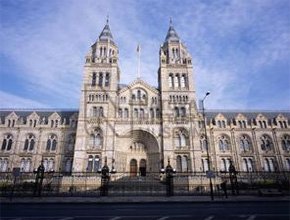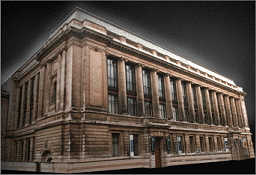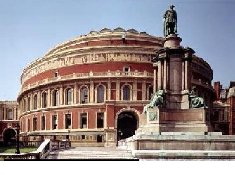Tour 2 - South Kensington to High Street
For tour map, click here.
Exit the South Kensington Street Station and make a right onto Thurloe Street and then left onto Thurloe Square and then right onto Thurloe Place. You'll see #33, the home of Sir Henry Cole. Many of you will recall that he was the designer of the "first" Christmas card.
Kensington Museum
Continue on Cromwell and then turn right onto Princess Gate where you'll come upon the Kensington Museum (to be renamed in 1899 to the Victoria and Albert Museum) established in 1852. Its first director was Sir Henry Cole. The museum has featured exhibits on arts and science until the scientific collection was moved to its own museum (Science Museum). The building is of Victorian and Edwardian design and covers 11 acres. It's located near the Science and Natural History museums.
Museum of Natural History/Science Museum
|
The Natural History Museum facing Cromwell is home to life and earth science collections comprising some 70 million items. It features a wildlife garden containing native fauna and flora. The museum is renowned for its exhibition of dinosaur skeletons, particularly the large Diplodocus cast which dominates the entrance. Work to expand the museum began in 1873 and the new museum is expected to open in the early 1880s. The Science Museum is across the street. |
  |
|
Royal Albert Hall Make a right onto Kensington Road and you'll come to the Royal Albert Hall. Opened to the public in May 1871, the Hall is a huge building of elliptical form in the style of the Italian Renaissance, constructed of red brick and terra-cotta. It was designed by Fowke and Scott, and cost approximately £200,000. The dimensions are 200 feet in length, 160 feet in breadth, and 140 feet in height. The interior, which is very elegant, is capable of holding 10,000 persons. A grand organ, one of the largest in the world, occupies one end and is surrounded by an extensive orchestra. The building is used for exhibitions of science and art, oratorios, and concerts. |
 |
At the top of the hall is a picture gallery, capable of accommodating 2,000 persons, and used on ordinary occasions as a promenade. There are hydraulic lifts to the upper floors. The hall is 135 feet in height, and is crowned by a domed skylight of painted glass, having a central opening or lantern, with a star of gasburners. Altogether the hall is calculated to hold an audience of about 8,000. It features an organ built by Henry Willis, featuring five rows of keys--belonging to the choir, great, solo, swell, and pedal organs--130 stops, and 10,000 pipes, the range of which is ten octaves. The orchestra accommodates 1,000 performers.
Kensington Gate
Walk around Hyde Park Gate and you'll find the homes of artist Sir John Everett Millas (No. 2), and poet Robert Browning (No. 29 De Vere Gardens). Continue on down Kensington to Kensington Square and you'll come to the homes of philosopher John Stuart Mill (No. 18 Kensington Square), Sir John Simon (health and sanitation reformer, No. 40 Kensington Square) and author William Makepeace Thackeray (No. 41 Kensington Square).
Back to Intro/Index or Site Map
| | Family Gallery | Servants Parlour | Tour Home | Typical Day | Etiquette | Shopping Trip | |
| | Victorian Christmas | Victorian England Fun and Games | Ashton Library | Victorian Wedding | |
| | Victorian England Overview | Guest Registry | Honorary Victorian | Tours | |
| | Awards Received | Bibliography | |
| | 1876 Victorian England Home | |
Credits below copyright information |
| Contact
webmaster |
| Copyright
1999-2017 All Rights Reserved - B. Malheiro May not be reproduced in any way without express written permission of webmaster. |
Credits:
Background set and buttons are the creation of webmaster, B. Malheiro. These images have been watermarked and are not for use on another site.